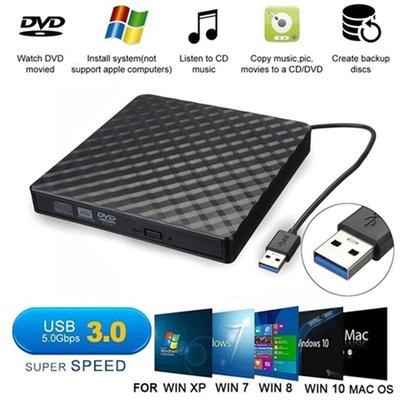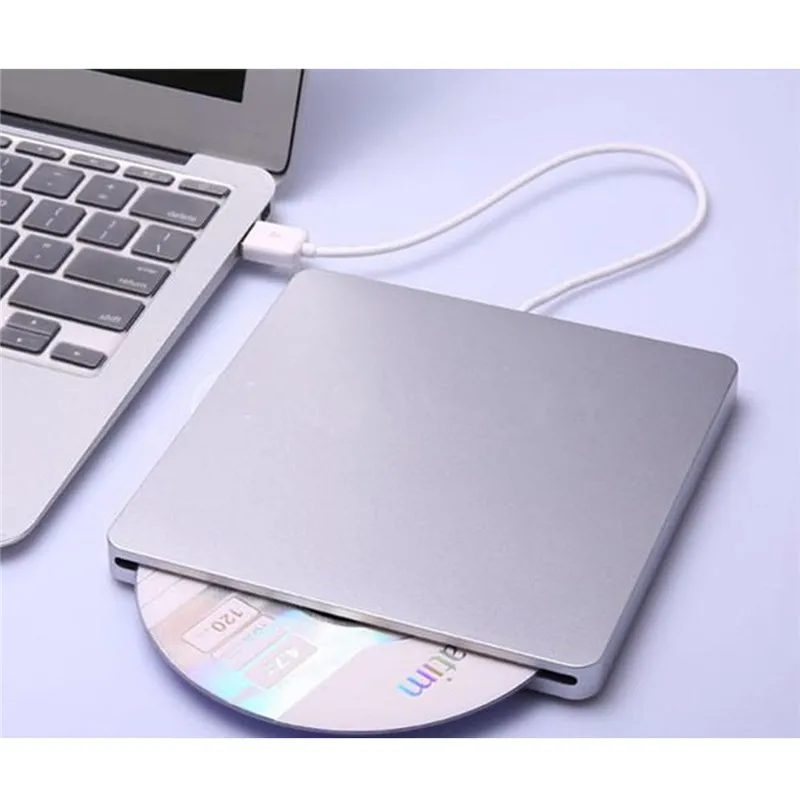Information about these and other types of Mac ports is in the specifications for your Mac: Choose Apple menu > About This Mac, click Support, then click Specifications. Or check your Mac user guide.
Important: If your Mac has a single USB-C port, use a multiport adapter. Connect the printer, then connect a USB-C cable to a power supply to prolong the battery life of your Mac. See About USB-C. For information about adding an AirPrint-enabled printer using USB, see Add your printer with different settings. External CD DVD Drive Type C USB 3.0 Portable High-Speed CD/DVD +/-RW Drive CD DVD ROM Rewriter Reader Burner Writer for Laptop PC Desktop MacBook Mac Windows 7/8/10 Linux OS Apple.
Thunderbolt 3
Use Thunderbolt 3 with displays and other devices that connect using either a Thunderbolt 3 cable or USB-C cable. You can also connect a USB-C power adapter and cable to charge your notebook computer. If you have a device that doesn't connect to this port, you might be able to use an adapter to connect it.
Reader Ned Mitchell find his MacBook’s media drive is a little picky about the discs he inserts. He writes: My MacBook’s internal CD/DVD drive reads DVDs just fine. Burn CDs and DVDs on Mac. If your Mac has a built-in optical drive, or if you connect an external DVD drive (for example, an Apple USB SuperDrive), you can burn files to CDs and DVDs to share your files with friends, move files between computers, or create backup files.
These Mac models have Thunderbolt 3 ports:
- MacBook Pro introduced in 2016 or later
- MacBook Air introduced in 2018 or later
- iMac introduced in 2017 or later
- iMac Pro (all models)
- Mac mini introduced in 2018
- Mac Pro introduced in 2019
If your Mac notebook or desktop computer has more than one port like this, each port supports ThunderBolt 3 and USB-C.
USB-C
Use USB-C with displays and other devices that connect using a USB-C cable. You can also connect a USB-C power adapter and cable to charge your notebook computer. If you have a device that doesn't connect to this port, you might be able to use an adapter to connect it.
MacBook models introduced in 2015 or later have a single USB-C port. This port doesn't support Thunderbolt devices.
If your Mac has only one port like this, it's a MacBook that supports USB-C but not Thunderbolt.
Thunderbolt
Use Thunderbolt or Thunderbolt 2 with displays and other devices that connect using a Thunderbolt cable.
These Mac models have Thunderbolt or Thunderbolt 2 ports:

- MacBook Pro introduced in 2011 until 2015
- MacBook Air introduced in 2011 until 2017
- Mac mini introduced in 2011 until 2014
- iMac introduced in 2011 until 2015
- Mac Pro introduced in 2013
Thunderbolt and Thunderbolt 2 are not the same as Mini DisplayPort . They have the same shape, but use different symbols on the cable and port. However, this port does support Mini DisplayPort for video output, so you can use a Mini DisplayPort cable to connect a Mini DisplayPort display.
Mini DisplayPort
Use Mini DisplayPort with displays that connect using a Mini DisplayPort cable.
These Mac models have Mini DisplayPort:
- MacBook Pro introduced in late 2008 until 2010
- MacBook Air introduced in late 2008 until 2010
- Mac mini introduced in 2009 and 2010
- iMac introduced in 2009 and 2010
- Mac Pro introduced in 2009 until 2012
Mini DisplayPort is not the same as Thunderbolt or Thunderbolt 2 . They have the same shape, but use different symbols on the cable and port.
USB-A
Use USB-A with devices that connect using a USB cable. USB ports are sometimes known by the USB specification of the port, such as USB 2 or USB 3.
Cd Reader For Mac
Left to right: power, two Thunderbolt, USB-A, and Audio-Out.
HDMI
Use HDMI with displays and TVs that connect using an HDMI cable.
Ethernet
Use Ethernet with networks and devices that connect using an Ethernet (RJ45) cable.
FireWire
Use FireWire with devices that connect using a FireWire 400 or FireWire 800 cable.
SD card
Use the SD card slot with SD, SDHC, SDXC, MMC and UHS-II media cards, such as those used by digital cameras.
Audio
Use Audio-Out – or – with headphones, speakers and other audio-output devices that connect using an audio cable that has a 3.5 mm (1/8 inch) audio jack.
Use Audio-In with a microphone or other audio-input device that connects using an audio cable that has a 3.5 mm (1/8 inch) audio jack.
Power

Use the power port , if available, to connect your computer to AC power using a MagSafe cable or adapter. This port isn't available on newer Mac notebook computers, which use Thunderbolt 3 or USB-C for power and charging. Learn more about power adapters and cables for Mac notebook computers.
Learn more
Tip
This guide assumes you have a grounding in the tools that Argo CD is based on. Please read understanding the basics to learn about these tools.
Requirements¶
- Installed kubectl command-line tool
- Have a kubeconfig file (default location is
~/.kube/config).
1. Install Argo CD¶
This will create a new namespace, argocd, where Argo CD services and application resources will live.
On GKE, you will need grant your account the ability to create new cluster roles:

Note
If you are not interested in UI, SSO, multi-cluster management and just want to pull changes into the cluster then you can disableauthentication using --disable-auth flag and access Argo CD via CLI using --port-forward or --port-forward-namespace flagsand proceed to step #6:
kubectl patch deploy argocd-server -n argocd -p '[{'op': 'add', 'path': '/spec/template/spec/containers/0/command/-', 'value': '--disable-auth'}]' --type json
2. Download Argo CD CLI¶
Download the latest Argo CD version from https://github.com/argoproj/argo-cd/releases/latest. More detailed installation instructions can be found via the CLI installation documentation.
Also available in Mac Homebrew:
3. Access The Argo CD API Server¶
By default, the Argo CD API server is not exposed with an external IP. To access the API server,choose one of the following techniques to expose the Argo CD API server:
Service Type Load Balancer¶
Change the argocd-server service type to LoadBalancer:
Ingress¶
Follow the ingress documentation on how to configure Argo CD with ingress.
Port Forwarding¶

Kubectl port-forwarding can also be used to connect to the API server without exposing the service.
The API server can then be accessed using the localhost:8080
4. Login Using The CLI¶
The initial password is autogenerated to be the pod name of theArgo CD API server. This can be retrieved with the command:
Using the username admin and the password from above, login to Argo CD's IP or hostname:
Change the password using the command:
5. Register A Cluster To Deploy Apps To (Optional)¶
This step registers a cluster's credentials to Argo CD, and is only necessary when deploying toan external cluster. When deploying internally (to the same cluster that Argo CD is running in),https://kubernetes.default.svc should be used as the application's K8s API server address.
Cd Port For Macbook Air
First list all clusters contexts in your current kubeconfig:
Choose a context name from the list and supply it to argocd cluster add CONTEXTNAME. For example,for docker-for-desktop context, run:
The above command installs a ServiceAccount (argocd-manager), into the kube-system namespace of that kubectl context, and binds the service account to an admin-level ClusterRole. Argo CD uses thisservice account token to perform its management tasks (i.e. deploy/monitoring).
Note
The rules of the argocd-manager-role role can be modified such that it only has create, update, patch, delete privileges to a limited set of namespaces, groups, kinds. However get, list, watch privileges are required at the cluster-scope for Argo CD to function.
6. Create An Application From A Git Repository¶
An example repository containing a guestbook application is available athttps://github.com/argoproj/argocd-example-apps.git to demonstrate how Argo CD works.
Creating Apps Via CLI¶
Note
You can access Argo CD using port forwarding: add --port-forward-namespace argocd flag to every CLI command or set ARGOCD_OPTS environment variable: export ARGOCD_OPTS='--port-forward-namespace argocd':
argocd app create guestbook --repo https://github.com/argoproj/argocd-example-apps.git --path guestbook --dest-server https://kubernetes.default.svc --dest-namespace default
_ports.jpg/350px-Mac_mini_(2018)_ports.jpg)
Creating Apps Via UI¶
Open a browser to the Argo CD external UI, and login by visiting the IP/hostname in a browser and use the credentials set in step 4.
After logging in, click the + New App button as shown below:
Give your app the name guestbook, use the project default, and leave the sync policy as Manual:
Connect the https://github.com/argoproj/argocd-example-apps.git repo to Argo CD by setting repository url to the github repo url, leave revision as HEAD, and set the path to guestbook:
For Destination, set cluster to in-cluster and namespace to default:
After filling out the information above, click Create at the top of the UI to create the guestbook application:
7. Sync (Deploy) The Application¶
Once the guestbook application is created, you can now view its status:
The application status is initially in OutOfSync state since the application has yet to bedeployed, and no Kubernetes resources have been created. To sync (deploy) the application, run:
This command retrieves the manifests from the repository and performs a kubectl apply of themanifests. The guestbook app is now running and you can now view its resource components, logs,events, and assessed health status:
From UI:¶
